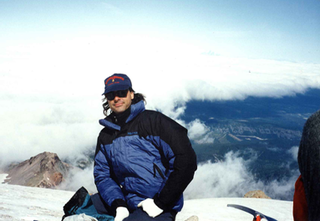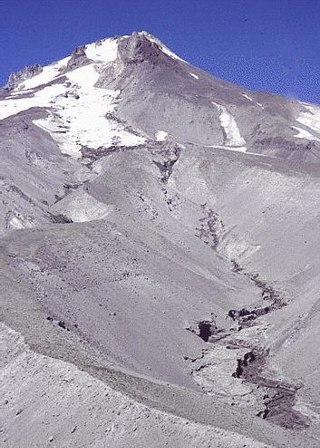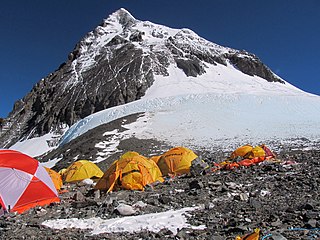Related Research Articles

Mount Everest(also Mount Sagarmatha or Mount Qomolangma) is Earth's highest mountain above sea level, located in the Mahalangur Himal sub-range of the Himalayas. The China–Nepal border runs across its summit point. Its elevation of 8,848.86 m was most recently established in 2020 by the Chinese and Nepali authorities.

Longs Peak is a high and prominent mountain in the northern Front Range of the Rocky Mountains of North America. The 14,259-foot (4346 m) fourteener is located in the Rocky Mountain National Park Wilderness, 9.6 miles (15.5 km) southwest by south of the Town of Estes Park, Colorado, United States. Longs Peak is the northernmost fourteener in the Rocky Mountains of Colorado and the highest point in Boulder County and Rocky Mountain National Park. The mountain was named in honor of explorer Stephen Harriman Long and is featured on the Colorado state quarter.

Mount Hood is an active stratovolcano in the Cascade Volcanic Arc. It was formed by a subduction zone on the Pacific coast and rests in the Pacific Northwest region of the United States. It is located about 50 mi (80 km) east-southeast of Portland, on the border between Clackamas and Hood River counties. In addition to being Oregon's highest mountain, it is one of the loftiest mountains in the nation based on its prominence, and it offers the only year-round lift-served skiing in North America.

Mount Adams, known by some Native American tribes as Pahto or Klickitat, is a potentially active stratovolcano in the Cascade Range. Although Adams has not erupted in more than 1,000 years, it is not considered extinct. It is the second-highest mountain in Washington, after Mount Rainier.

Three Fingered Jack is a summit of a shield volcano of the Cascade Range in the U.S. state of Oregon. Formed during the Pleistocene epoch, the mountain consists mainly of basaltic andesite lava and was heavily glaciated in the past. While other Oregon volcanoes that were heavily glaciated—such as Mount Washington and Mount Thielsen—display eroded volcanic necks, Three Fingered Jack's present summit is a comparatively narrow ridge of loose tephra supported by a dike only 10 feet (3.0 m) thick on a generally north–south axis. Glaciation exposed radiating dikes and plugs that support this summit. The volcano has long been inactive and is highly eroded.

Mount Timpanogos, often referred to as Timp, is the second-highest mountain in Utah's Wasatch Range. Timpanogos rises to an elevation of 11,752 ft (3,582 m) above sea level in the Uinta-Wasatch-Cache National Forest. With 5,270 ft (1,610 m) of topographic prominence, Timpanogos is the 47th-most prominent mountain in the contiguous United States.

Mount Lyell is the highest point in Yosemite National Park, at 13,114 feet (3,997 m). It is located at the southeast end of the Cathedral Range, 1+1⁄4 miles northwest of Rodgers Peak. The peak as well as nearby Lyell Canyon is named after Charles Lyell, a well-known 19th century geologist. The peak had one of the last remaining glaciers in Yosemite, Lyell Glacier. The Lyell Glacier is currently considered to be a permanent ice field, not a living glacier. Mount Lyell divides the Tuolumne River watershed to the north, the Merced to the west, and the Rush Creek drainage in the Mono Lake Basin to the southeast.

The Mount Hood Wilderness is a protected wilderness area inside the Mount Hood National Forest, in the U.S. state of Oregon. The area, covering 64,742 acres (26,200 ha), includes the peak of Mount Hood and its upper slopes, and ranges from temperate rain forests at the lower elevations, to glaciers and rocky ridges at higher elevations.

Jeffrey Kelly James was one of three experienced mountain climbers who died on Mount Hood in the U.S. state of Oregon in December 2006 in an incident that received worldwide attention.
A Mountain Locator Unit or MLU was a radio transmitter for use by mountain climbers as an emergency locator beacon when the wearer needs rescue.

Mount Hood climbing accidents are incidents related to mountain climbing or hiking on Oregon's Mount Hood. As of 2007, about 10,000 people attempt to climb the mountain each year. As of May 2002, more than 130 people are known to have died climbing Mount Hood since records have been kept. One of the worst climbing accidents occurred in 1986, when seven high school students and two teachers froze to death while attempting to retreat from a storm.

White River Glacier is an alpine glacier located on the south slopes of Mount Hood in the U.S. state of Oregon. It ranges in elevation from about 10,000 to 6,200 feet. It is among the best known of the twelve glaciers on the mountain, and the lower reaches are a popular destination for Nordic skiing enthusiasts. The glacier is the source of the White River, a tributary of the Deschutes River, and has a long history of washing out the bridge where Oregon Route 35 crosses at 45.30307°N 121.67208°W.

The 2009 Buachaille Etive Mòr avalanche happened on Buachaille Etive Mòr in Glen Coe in the Scottish Highlands, UK, on 24 January 2009. Three mountain climbers were killed and one sustained a serious shoulder injury. Two of the dead were from Northern Ireland and the other was from Scotland. Nine people from at least three countries in at least two parties were involved in the incident on a mountain that is well recognised by tourists to Scotland. While avalanches are not uncommon in the area, very few deaths are reported—this incident has been described as "one of the worst disasters in the Scottish mountains for decades".

Mount Maroon is a mountain in South East Queensland that is part of the McPherson Range. The mountain rises to 966 m (3,169 ft) above sea level about 12 km west of Rathdowney.
In the United States, mountain rescue is handled by professional teams within some national parks and by volunteer teams elsewhere. Volunteer teams are often members of the Mountain Rescue Association (MRA).
Portland Mountain Rescue is a search and rescue organization based in Portland, Oregon, United States. It specializes in high angle mountain rescue and mountain rescue in northwest Oregon and southwest Washington, as well as providing educational materials and information on mountain and backcountry safety. Secondary areas of operations include Central Oregon and western Washington. The organization is 100% volunteer and has about 65 field-deployable members.

Juneau Mountain Rescue (JMR) is a mountain search and rescue agency, located in Juneau, Alaska, United States. JMR is a member of the Alaska Search and Rescue Association, and facilitates rescues involving wilderness terrain, rope rescues on rock faces, ice and snow fields, glaciers, and during avalanches, medical evacuations, missing persons cases, aircraft crashes and other disasters. An all-volunteer organization, JMR coordinates with Capital City Fire/Rescue, the Juneau Police Department, the Alaska State Troopers, the United States Coast Guard, and other emergency response agencies during search and rescue operations.

The Mount Everest climbing season of 2013 included 658 summits and 8 deaths. Due to avalanches in 2014 and 2015, this was the last big summiting year until 2016.
The 1975 New Zealand bravery awards were announced via a Special Honours List dated 27 June 1975, and recognised three people for acts of bravery earlier that year.
Peter H. Hackett is an American mountaineer and medical doctor. He is the third person to have summited Mount Everest in a solo ascent, climbing from South Col to the top on October 24, 1981. He studies the effect of altitude on human physiology, and is the founder of a medical rescue camp on Everest and a rescue clinic and lab on Mount Denali, and the director of the Institute for Altitude Medicine in Colorado.
References
- 1 2 3 Alfonso Serrano (February 20, 2007). "Dog Helped Saved [sic] Mount Hood Climbers—Rescued Man And Two Women Taken To Hospital, Expected To Be Fine". CBS News. Archived from the original on February 22, 2007. Retrieved December 29, 2019.
- ↑ "Climbers leave Mount Hood; rescuer credits black Lab with saving their lives". WSVN-TV. Fort Lauderdale, Florida. February 19, 2007. Archived from the original on July 28, 2011. Retrieved December 16, 2009.
- ↑ "Mount Hood climbers reach safety". NBC News. February 20, 2007. Retrieved December 16, 2009.
- ↑ "Donor, Inspired by Mt. Hood Hero Dog, Names Assistance Fund" (PDF). dovelewis.org. May 14, 2007. Retrieved December 16, 2009.[ dead link ]